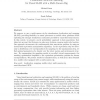Free Online Productivity Tools
i2Speak
i2Symbol
i2OCR
iTex2Img
iWeb2Print
iWeb2Shot
i2Type
iPdf2Split
iPdf2Merge
i2Bopomofo
i2Arabic
i2Style
i2Image
i2PDF
iLatex2Rtf
Sci2ools
CVIU
2010
2010
Probabilistic structure matching for visual SLAM with a multi-camera rig
We propose to use a multi-camera rig for simultaneous localization and mapping (SLAM), providing flexibility in sensor placement on mobile robot platforms while exploiting the stronger localization constraints provided by omni-directional sensors. In this context, we present a novel probabilistic approach to data association, that takes into account that features can also move between cameras under robot motion. Our approach circumvents the combinatorial data association problem by using an incremental expectation maximization algorithm. In the expectation step we determine a distribution over correspondences by sampling. In the maximization step, we find optimal parameters of a density over the robot motion and environment structure. By summarizing the sampling results in so-called virtual measurements, the resulting optimization simplifies to the equivalent optimization problem for known correspondences. We present results for simulated data, as well as for data obtained by a mobile...
| Added | 10 Dec 2010 |
| Updated | 10 Dec 2010 |
| Type | Journal |
| Year | 2010 |
| Where | CVIU |
| Authors | Michael Kaess, Frank Dellaert |
Comments (0)

